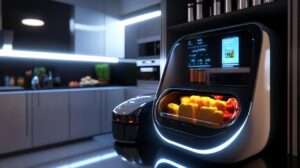The modern kitchen has evolved beyond traditional tools and techniques, with professional kitchen robots now representing a significant investment for both commercial establishments and home cooking enthusiasts. As the market expands and technology advances, navigating the wealth of options available through online retailers requires careful consideration and strategic planning to ensure you select the right equipment for your specific needs whilst securing the best possible value.
Researching before you purchase your kitchen robot
Reading genuine customer reviews and ratings
Before committing to any purchase, particularly one that represents a substantial financial outlay such as a professional kitchen robot, taking the time to thoroughly examine authentic customer feedback proves invaluable. Genuine reviews from verified purchasers offer insights that manufacturer specifications simply cannot provide, revealing real-world performance, durability concerns, and practical applications that only emerge through extended use. When reading through customer testimonials, look beyond the star ratings and delve into detailed accounts that discuss specific aspects such as ease of programming, reliability during continuous operation, and how well the equipment integrates with existing kitchen workflows. This online shopping guide approach helps distinguish between isolated complaints and recurring issues that might signal fundamental design flaws or compatibility challenges.
Pay particular attention to reviews from users operating in similar environments to your own, whether that means high-volume commercial kitchens facing staff shortages or smaller establishments seeking to enhance food consistency. Professional kitchen robots designed for restaurant automation often feature advanced capabilities powered by artificial intelligence and machine learning, enabling them to adapt to various cooking tasks whilst maintaining hygiene standards and food safety protocols. Customer feedback frequently highlights whether these sophisticated systems deliver on their promises or fall short in practical application, particularly regarding operational efficiency and ease of maintenance. Reviews that discuss the learning curve associated with workforce training can prove especially valuable, as they provide realistic expectations about the time investment required before achieving optimal results.
Comparing specifications across different models
Technical specifications represent the foundation upon which purchasing decisions should rest, yet understanding how to interpret and compare these details across different models requires careful attention to what matters most for your intended applications. Key specifications to scrutinise include payload capacity, which determines the weight the robot can safely handle during food preparation tasks, and reach, which affects the workspace the equipment can cover without repositioning. Repeatability, often expressed in millimetres, indicates how precisely the robot can return to the same position repeatedly, a crucial factor for ensuring food consistency across hundreds or thousands of servings.
Programming ease varies considerably between models, with some kitchen robots requiring specialist knowledge whilst others feature intuitive interfaces that allow staff to configure new tasks with minimal training. The end-effector, or gripper technology, determines what the robot can physically manipulate, from delicate ingredients requiring gentle handling to robust equipment for flipping burgers or managing hot oil operations. Sensor integration enhances safety and precision, enabling robots to detect temperature variations, adjust to different ingredient textures, and respond to unexpected obstacles in their operational environment. When comparing models, consider how collaborative robots might fit into your existing space without necessitating extensive kitchen redesigns, as equipment that slots seamlessly into current layouts minimises disruption and reduces implementation costs.
Securing the Best Deal for Your Kitchen Robot

Price comparison strategies across retailers
The financial investment required for professional kitchen robots demands a methodical approach to identifying the most competitive pricing across various online retailers and direct manufacturers. Prices for these sophisticated systems vary dramatically based on capabilities, with entry-level models suitable for basic repetitive tasks starting at several thousand pounds, whilst advanced systems featuring comprehensive artificial intelligence and multi-functional capabilities can exceed fifty thousand pounds. Established manufacturers such as Miso Robotics, known for their Flippy robot, and Standard Bots, offering models like the RO1 robot with flexible lease models, present different purchasing options that warrant careful comparison.
When evaluating pricing structures, look beyond the headline purchase price to consider total cost of ownership, which encompasses ongoing expenses such as equipment maintenance, software updates, and potential modifications to accommodate evolving operational needs. Some suppliers offer lease models that reduce upfront capital requirements, with monthly payments that can be offset against the cost reduction achieved through improved labour efficiency and waste reduction. The fast food industry has particularly embraced these flexible payment structures, as they allow businesses to trial periods with new technology before committing to outright purchase. Data-driven insights from early adopters suggest that return on investment typically materialises within eighteen to thirty-six months, depending on usage intensity and the specific labour costs being offset, making the comparison of long-term value propositions as important as initial price points.
Understanding return policies and warranty coverage
Comprehensive protection through robust return policies and extensive warranty coverage provides essential peace of mind when investing in sophisticated kitchen automation technology. Before finalising any purchase, scrutinise the terms governing equipment warranty provisions, paying particular attention to what components and failures are covered, the duration of protection, and any conditions that might void coverage such as unauthorised modifications or inadequate maintenance. Quality manufacturers typically offer warranties ranging from twelve months for basic models to three years or more for premium systems, reflecting their confidence in build quality and reliability.
Return policies deserve equally thorough examination, as they provide crucial flexibility should the equipment prove unsuitable for your specific operational requirements or arrive damaged during shipping. Look for retailers offering trial periods that allow you to test the robot within your actual working environment, as this hands-on evaluation reveals compatibility issues that cannot be assessed through specifications alone. Some forward-thinking suppliers provide expert consultation services, including site visits to assess your kitchen layout and operational needs before recommending specific models, reducing the likelihood of purchasing inappropriate equipment. Understanding the process for initiating returns, including who bears shipping costs for large, heavy equipment and the timeframe within which returns must be requested, prevents unpleasant surprises should circumstances necessitate returning your purchase. The availability of ongoing technical support and access to replacement parts also merits consideration, as even the most reliable kitchen robots will eventually require servicing to maintain optimal performance and hygiene standards throughout their operational lifespan.







